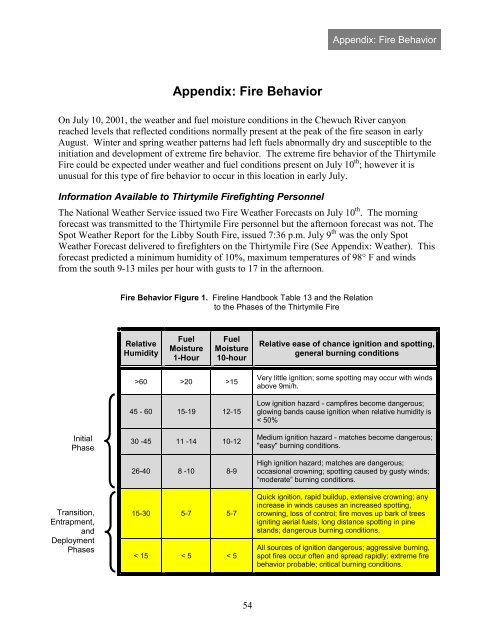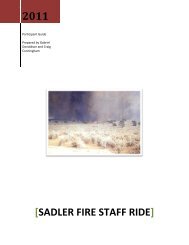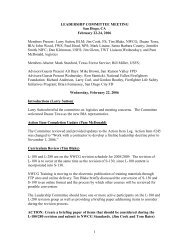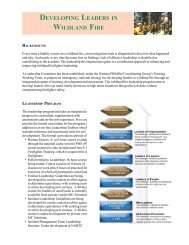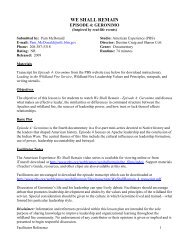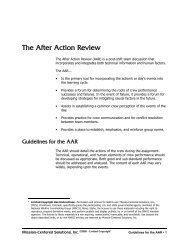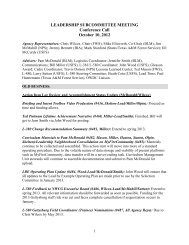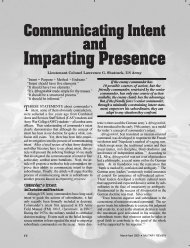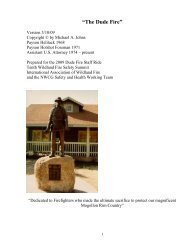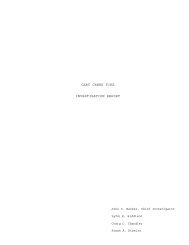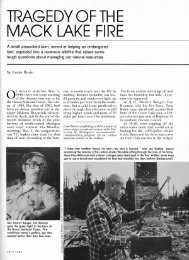Thirtymile Fire - USDA Forest Service
Thirtymile Fire - USDA Forest Service
Thirtymile Fire - USDA Forest Service
Create successful ePaper yourself
Turn your PDF publications into a flip-book with our unique Google optimized e-Paper software.
Appendix: <strong>Fire</strong> Behavior<br />
Appendix: <strong>Fire</strong> Behavior<br />
On July 10, 2001, the weather and fuel moisture conditions in the Chewuch River canyon<br />
reached levels that reflected conditions normally present at the peak of the fire season in early<br />
August. Winter and spring weather patterns had left fuels abnormally dry and susceptible to the<br />
initiation and development of extreme fire behavior. The extreme fire behavior of the <strong>Thirtymile</strong><br />
<strong>Fire</strong> could be expected under weather and fuel conditions present on July 10 th ; however it is<br />
unusual for this type of fire behavior to occur in this location in early July.<br />
Information Available to <strong>Thirtymile</strong> <strong>Fire</strong>fighting Personnel<br />
The National Weather <strong>Service</strong> issued two <strong>Fire</strong> Weather Forecasts on July 10 th . The morning<br />
forecast was transmitted to the <strong>Thirtymile</strong> <strong>Fire</strong> personnel but the afternoon forecast was not. The<br />
Spot Weather Report for the Libby South <strong>Fire</strong>, issued 7:36 p.m. July 9 th was the only Spot<br />
Weather Forecast delivered to firefighters on the <strong>Thirtymile</strong> <strong>Fire</strong> (See Appendix: Weather). This<br />
forecast predicted a minimum humidity of 10%, maximum temperatures of 98° F and winds<br />
from the south 9-13 miles per hour with gusts to 17 in the afternoon.<br />
<strong>Fire</strong> Behavior Figure 1. <strong>Fire</strong>line Handbook Table 13 and the Relation<br />
to the Phases of the <strong>Thirtymile</strong> <strong>Fire</strong><br />
Relative<br />
Humidity<br />
Fuel<br />
Moisture<br />
1-Hour<br />
Fuel<br />
Moisture<br />
10-hour<br />
Relative ease of chance ignition and spotting,<br />
general burning conditions<br />
Initial<br />
Phase<br />
Transition,<br />
Entrapment,<br />
and<br />
Deployment<br />
Phases<br />
>60 >20 >15<br />
45 - 60 15-19 12-15<br />
30 -45 11 -14 10-12<br />
26-40 8 -10 8-9<br />
15-30 5-7 5-7<br />
< 15 < 5 < 5<br />
Very little ignition; some spotting may occur with winds<br />
above 9mi/h.<br />
Low ignition hazard - campfires become dangerous;<br />
glowing bands cause ignition when relative humidity is<br />
< 50%<br />
Medium ignition hazard - matches become dangerous;<br />
"easy" burning conditions.<br />
High ignition hazard; matches are dangerous;<br />
occasional crowning; spotting caused by gusty winds;<br />
“moderate” burning conditions.<br />
Quick ignition, rapid buildup, extensive crowning; any<br />
increase in winds causes an increased spotting,<br />
crowning, loss of control; fire moves up bark of trees<br />
igniting aerial fuels; long distance spotting in pine<br />
stands; dangerous burning conditions.<br />
All sources of ignition dangerous; aggressive burning,<br />
spot fires occur often and spread rapidly; extreme fire<br />
behavior probable; critical burning conditions.<br />
54


